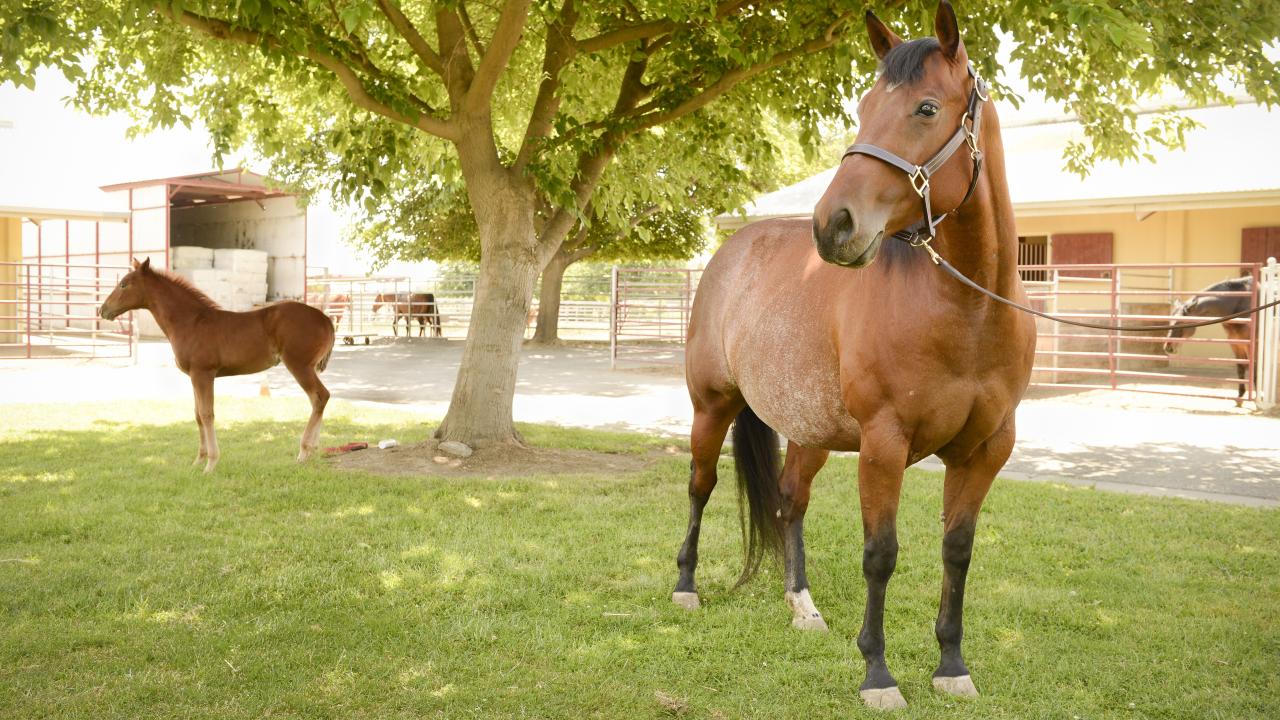CAHFS Connection July 2024

Managing Editor: Kerry Ballinger
Design Editor: Lucy Gomes
Contributors: Beate Crossley, Daniel Gornatti Churria, Eileen Henderson, Francisco Uzal, Javier Asin, Mark Anderson, Nicolas Streitenberger, Omar Gonzales Viera

Highly Pathogenic Avian Influenza (HPAI) H5N1 Virus in Livestock
As CAHFS and CDFA continue to monitor the situation in California, please be aware of the rules to test for highly pathogenic avian influenza H5N1 in livestock in California.
Please see end of this newsletter for comprehensive details.
Avian
Pigeon circovirus (PiCV), pigeon herpesvirus (PiHV), rotavirus infection, and necrotic enteritis (NE) were diagnosed in three juvenile, male, pen-reared squabs. The pigeons belonged to a loft composed of 700 birds divided into 20 pens. In two pens, birds had a 1-week history of vomiting and weight loss. Grossly, the three pigeons submitted had moderately decreased pectoral muscles, thickened crop walls, and enlarged, greenish livers. Microscopically, the crop had lesions compatible with PiHV infection. The livers had multifocal necrosis from which pigeon rotavirus was detected by qPCR. The small intestine lesions were compatible with necrotic enteritis and immunohistochemistry was positive for both Clostridium perfringens and Paeniclostridium sordellii. The bursas of Fabricius had lymphoid depletion and numerous viral inclusion bodies consistent with PiCV infection. PiCV infection can lead to immunosuppression producing the so-called “young pigeon disease syndrome”, which predisposes to a plethora of secondary infections, including PiHV infection and NE, as in this case.
Bovine
Infectious bovine rhinotracheitis (IBR) was diagnosed in a 5-month-old Jersey heifer with necrotizing tracheitis. IBR virus was detected by PCR. Additionally, this animal had bilateral fibrinonecrotic pleuropneumonia from which Mannheimia haemolytica and Mycoplasma bovis were detected.
Gas gangrene, ruminal acidosis with secondary zygomycosis, embolic hepatitis, and bacterial bronchopneumonia were diagnosed in a 5-year-old Holstein cow with a 7-day history of being down and suspicion of hypocalcemia. There was fibrinosuppurative and emphysematous cellulitis with gram-positive bacilli on the ventral abdomen. Clostridium septicum and Clostridium chaouvoei were detected, which are amongst the most common causes of gas gangrene. The ruminal fluid pH was 4.5 (normal range 5.5-6.4), and there was rumenitis with vasculitis and fungal hyphae consistent with zygomycetes. There was also embolic hepatitis with intravascular zygomycetes and areas of necrosis, and Salmonella Dublin was recovered from the liver. Bilateral bacterial bronchopneumonia was affecting the cranioventral aspect of the lungs.
Severe bilateral fibrinonecrotic bronchopneumonia caused by Mannheimia haemolytica, Mycoplasma bovis, and bovine respiratory syncytial virus was diagnosed in a 22-day-old heifer from a calf ranch.
Camelids
Severe proliferative gastritis of the third compartment caused by Camelostrongylus mentulatus was the cause of the emaciation in a 9-year-old female llama. This trichostrongyle can infect New World camelids and small ruminants localizing in the third compartment and abomasum, respectively.

Equine
An unusual case of enterotyphlocolitis associated with Streptococcus equi ssp zooepidemicus and Paeniclostridium sordellii was diagnosed in a 3-year-old miniature horse/Shetland pony cross gelding that was euthanized after a 1-2-day history of profuse diarrhea. At necropsy, there were annular segments of hemorrhage and necrosis in the small intestine that were centered on the Peyer’s patches. The large colon and cecum had edematous walls and contained watery digesta. Histologically, fibrinosuppurative and necrotizing enterotyphlocolitis was observed. S. equi ssp zooepidemicus and P. sordellii were isolated from the small intestine and cecum. These bacteria have been isolated in other cases of enterotyphlocolitis in horses and, although a definitive association with the disease has not been confirmed, they are suspected to play a role.
Small Ruminants
Mycoplasma pleuropneumonia was the cause of death in adult first to third lactation, postpartum does from a 1000 head goat dairy where 100 animals were sick and 15 had died over one week. Affected goats exhibited one or more of the following signs: open-mouth breathing, harsh ventral lung sounds, fever over 105oF, and foaming at the mouth. Field necropsies revealed pleural effusion and pneumonia or pulmonary edema, congestion, and hemorrhage. Mycoplasma was isolated from the lungs of five goats submitted and all five were PCR positive for goat type Mycoplasma. Further molecular characterization identified Mycoplasma mycoides subspecies capri.
Holiday Schedule
CAHFS laboratories will be closed on Thursday, July 4th in observance of Independence Day.
CAHFS is Hiring!
Davis
SRA 2 (Analytical Chemist) - 68580
Under general direction of the supervisor, perform organic and inorganic analyses for the determination of components in animal feed samples, as well as for the determination of synthetic toxicants and naturally occurring toxins in animal tissues, biological specimens, and source material. Prepare feed samples for testing using grinding and homogenization equipment. Prepare tissue and other types of samples for testing by portioning and weighing. Follow relevant laboratory SOPs for sample preparation. Responsible for maintaining quality control and participating in the update and ongoing assessment of analytical procedures.
Financial Services Supervisor -70449
Under the general direction of the CAHFS Business Officer, oversees centralized financial services for CAHFS’ four branch locations, supporting approximately 200 faculty, staff and students in the areas of accounts payable (AP), travel, entertainment, and procurement, and provides direct supervision of Business Office staff and front desk reception for the Davis laboratory. Serves as a technical lead and subject matter expert in assigned areas and as the CAHFS Fiscal Officer; responsible for review and approval of financial documents for accuracy and appropriateness, ensuring accountability and compliance with University Policy and Procedures and liaising with central campus units to clarify policy and resolve issues as needed; departmental chart of accounts management; performing monthly account ledger review; and managing fiscal close activities. Responsible for conducting analytical studies on Business Office functions; short- and long-range planning efforts; ensuring productivity/performance measures are met; and establishing, implementing, and documenting system-wide operating procedures for financial functions.
Asst/Assoc/Full Professor of Clinical Diagnostic Toxicology
The successful candidate is responsible for diagnostic toxicology throughout the four laboratories that comprise CAHFS. Emphasis will be placed on the diagnosis of toxicoses affecting the livestock and poultry industries, animal production and food from animal sources as well as wildlife and companion animals.
Highly Pathogenic Avian Influenza (HPAI) H5N1 Virus in Livestock – cont’d
Protocol for cows with clinical signs of HPAI
- For dairies with suspect clinical signs contact your CDFA Animal Health Branch district office for regulatory personnel to conduct a Foreign Animal Disease investigation (FADi).
Protocol for lactating dairy cattle moving interstate (not direct to slaughter movements)
- All lactating dairy cattle moving interstate require a Certificate of Veterinary Inspection (CVI) and matrix-A negative HPAI test from a National Animal Health Laboratory Network (NAHLN) laboratory within seven (7) days of movement in addition to any further entry requirements of state of destination.
- Samples must be collected by an accredited veterinarian, a sample collector approved by a state animal health official, or a designated individual at a farm that was trained to collect milk.
- The samples must be sent to an approved NAHLN laboratory (UC Davis California Animal Health and Food Safety (CAHFS) Laboratory Davis Branch is currently the only approved laboratory in California)
- For groups/lots of 30 or fewer animals moving interstate, all animals being moved must be tested. If more than 30 animals are moving interstate, only 30 animals total must be tested.
Protocol for surveillance testing using Bulk Tank (preferred surveillance method)
- Can be used for a herd of any size
- Bulk tank sample needs to be representative of all cattle in a lactating herd in a 24 hour period
- Collect sample from the bulk tank
- Collect sample from the sick pen
Protocol for surveillance testing individual animals
- Herd with less than 33 head: sample all lactating cows
- Herd with less than 1000 head: sample 33 lactating cows
- Herd with more than 1000 head: sample 34 lactating cows
Protocol for non-lactating dairy cattle moving interstate and any dairy cattle moving interstate direct to slaughter:
- Currently no testing required, must have a CVI issued within seven (7) days of movement in addition to any further entry requirements of state of destination.
CDFA has a voluntary herd monitoring program available for interested producers. More information can be found on the CDFA HPAI website.
General recommendations:
- Please use screw cap tubes only for submitting milk to prevent leaking during transport.
- Please submit 8-10ml milk per sample
- Ship samples Priority or First Overnight. Saturday arrival shipments should be prevented

The submitter needs to email the CAHFS submission form to the HPAI coordinator at: HPAI.LabCoordinator@cdfa.ca.gov
Additional information is available at https://www.cdfa.ca.gov/AHFSS/Animal_Health/HPAI.html
